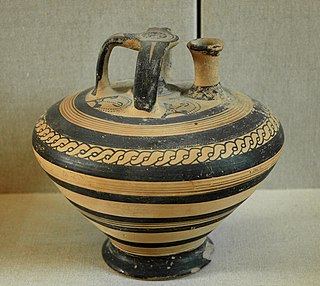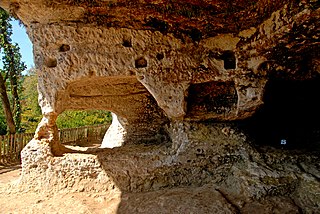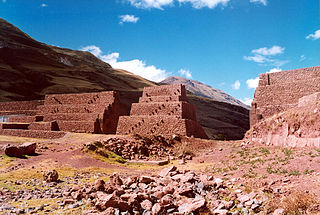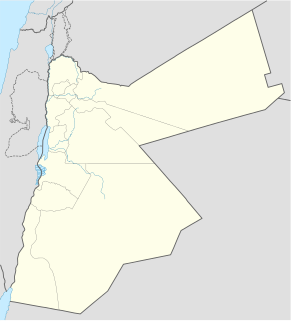The Iron Age is the final epoch of the three-age division of the prehistory and protohistory of humanity. It was preceded by the Stone Age and the Bronze Age. The concept has been mostly applied to Europe and the Ancient Near East, and, by analogy, also to other parts of the Old World.

The Levant is an approximate historical geographical term referring to a large area in the Eastern Mediterranean region of Western Asia. In its narrowest sense, it is equivalent to the historical region of Syria, which included present-day Syria, Lebanon, Jordan, Israel and Palestine. In its widest historical sense, the Levant included all of the Eastern Mediterranean with its islands; that is, it included all of the countries along the Eastern Mediterranean shores, extending from Greece to Cyrenaica in eastern Libya.

The Olmecs were the earliest known major civilization in Mesoamerica following a progressive development in Soconusco. They lived in the tropical lowlands of south-central Mexico, in the present-day states of Veracruz and Tabasco. It has been speculated that the Olmecs derive in part from neighboring Mokaya or Mixe–Zoque.

The Palatine Hill, which is the centremost of the Seven Hills of Rome, is one of the most ancient parts of the city and has been called "the first nucleus of the Roman Empire." It stands 40 metres above the Roman Forum, looking down upon it on one side, and upon the Circus Maximus on the other. From the time of Augustus Imperial palaces were built here. Prior to extensions to the Palace of Tiberius and the construction of the Domus Augustana by Domitian, 81-96 AD, the hill was mostly occupied by the houses of the rich. The perimeter measures 2,182 meters and the area is 255,801 square meters or 63 acres, with a circumference of 1,740 meters while the Regionary Catalogues of the fourth century give a perimeter of 11,510 feet or 3,402 meters.

An artifact, or artefact, is something made or given shape by humans, such as a tool or a work of art, especially an object of archaeological interest.

Israel Finkelstein is an Israeli archaeologist. He is the Jacob M. Alkow Professor of the Archaeology of Israel in the Bronze and Iron Ages at Tel Aviv University. Finkelstein is active in the archaeology of the Levant and an applicant of archaeological data in reconstructing biblical history. He is also known for applying the exact and life sciences in archaeological and historical reconstruction. Finkelstein is the current excavator of Megiddo, a site for the study of the Bronze and Iron Ages in the Levant.
The Archaeological Institute of America (AIA) is a North American nonprofit organization devoted to the promotion of public interest in archaeology, and the preservation of archaeological sites. It has offices on the campus of Boston University and in New York City.

La Hougue Bie is a historic site, with museum, in the Jersey parish of Grouville. La Hougue Bie is depicted on the 2010 issue Jersey 1 pound note.

La Cotte de St Brelade is a Paleolithic site of early habitation in Saint Brélade, Jersey. Cotte means "cave" in Jèrriais. The cave is also known as Lé Creux ès Fées.
Michael Alexander Arbuthnot is an archaeologist, instructor and archaeological filmmaker.
Archaeology, or archeology, is the study of human activity through the recovery and analysis of material culture. The archaeological record consists of artifacts, architecture, biofacts or ecofacts and cultural landscapes. Archaeology can be considered both a social science and a branch of the humanities. In Europe it is often viewed as either a discipline in its own right or a sub-field of other disciplines, while in North America archaeology is a sub-field of anthropology.

Charles T. Meide, Jr., known as Chuck Meide, is an underwater and maritime archaeologist and currently the Director of LAMP, the research arm of the St. Augustine Lighthouse & Museum located in St. Augustine, Florida. Meide was born in Jacksonville, Florida, and raised in the nearby coastal town of Atlantic Beach. He earned BA and MA degrees in Anthropology with a focus in underwater archaeology in 1993 and 2001 from Florida State University, where he studied under George R. Fischer, and undertook Ph.D. studies in Historical Archaeology at the College of William and Mary starting the following year. Meide has participated in a wide array of shipwreck and maritime archaeological projects across the U.S., especially in Florida, and throughout the Caribbean and Bermuda and in Australia and Ireland. From 1995 to 1997 he participated in the search for, discovery, and total excavation of La Salle's shipwreck, La Belle, lost in 1686. In 1999 he directed the Dog Island Shipwreck Project, a comprehensive maritime survey of the waters around a barrier island off the coast of Franklin County, Florida, and between 2004 and 2006 he directed the Achill Island Maritime Archaeology Project off the coast of County Mayo, Ireland. Since taking over as Director of LAMP in 2006, he has directed the First Coast Maritime Archaeology Project, a state-funded research and educational program focusing on shipwrecks and other maritime archaeological resources in the offshore and inland waters of Northeast Florida. In 2009, during this project, Meide discovered the "Storm Wreck," a ship from the final fleet to evacuate British troops and Loyalist refugees from Charleston at the end of the Revolutionary War, which wrecked trying to enter St. Augustine in late December 1782. He led the archaeological excavation of this shipwreck site each summer from 2010 through 2015. Starting in 2016, Meide has directed the ongoing excavation of the "Anniversary Wreck," another 18th-century shipwreck believed to represent a merchant vessel lost while trying to enter St. Augustine.

The archaeological site Abri de la Madeleine is a rock shelter under an overhanging cliff situated near Tursac, in the Dordogne département of the Aquitaine Région of South-Western France. It represents the type site of the Magdalenian culture of the Upper Paleolithic. The Bison Licking Insect Bite, a 20,000 year old carving of exceptional artistic quality was excavated at the site. The shelter was also occupied during the Middle Ages. The medieval castle of Petit Marsac stands on the top of the cliff just above the shelter. An engraved bone rod from the cave, depicting a lioness licking the opening of either a gigantic human penis or a vulva, shows the first documented act of bestiality.

Cave del Valle, locally also known as La Viejarrona, is located near El Cerro Village in the municipality of Rasines in Cantabria, northern Spain. The cave is the source of the Silencio River, a tributary of the Rio Ruahermosa, which in turn is a tributary of the Asón River. Notable for its prehistoric, but particularly for its speleologic significance as it is recognized as one of the longest cavities in the world. The site is very popular among cavers, who have explored a total of over 60 km (37.28 mi) so far.

La Milpa is an archaeological site and an ancient Maya city within the Three River region of Northwest Belize bordering Mexico and Guatemala. La Milpa is located between the sites of Rio Azul and Lamanai. Currently, La Milpa lies within the nature preserve owned by the Programme for Belize, a non-profit organization. PfB acquired land for the preserve from the Coco-Cola Company, who purchased land in Belize in 1988 with the goals of tearing down the rainforest to create a citrus plantation, however donated the land to conservation and management project in 1990 and 1992. Following Caracol and Lamanai, La Milpa is the third largest site in Belize with the Main Plaza alone covering 18,000 square meters, making it one of the largest in the entire Maya region.

Rumicolca is an archaeological site in Peru. It is located in the Cusco Region, Quispicanchi Province, Lucre District. Rumicolca is situated near the archaeological sites Chuqi Pukyu and Pikillaqta, east of Lake Huacarpay.

Roca dels Bous is an archaeological site located in Sant Llorenç de Montgai, in the Catalan Pyrenees, Spain. Since 1988 the Autonomous University of Barcelona and the UCL Institute of Archaeology study and record the fossil sequence of southern European Neanderthals who inhabited the area during the Middle Paleolithic approximately 50,000 years ago. The excavation team utilizes a worldwide unique digital system and various innovative technologies, that significantly improve the quality of the classification of the recovered objects. Roca dels Bous has as one of the first Paleolithic excavation sites in Spain established a visitor centre, that focuses on displaying the Prehistory research of the prepyrenees area.

Tall al-’Umayri is an archaeological dig site in western Jordan that dates back to The Early Bronze Age and extends forwards to the Hellenistic Period. It is located near the modern capital of Amman, and is significant for its well preserved evidence of a Temple, as well as archaeological evidence of a network of small farms believed to produce wine. Excavations were proceeding as of 2014.

Archaeology is promoted in Jersey by the Société Jersiaise and by Jersey Heritage. Promotion in the Bailiwick of Guernsey being undertaken by La Société Guernesiaise, Guernsey Museums, the Alderney Society with World War II work also undertaken by Festung Guernsey.
The Cueva de Bedmar is an archaeological site ranging from the Middle Paleolithic to the Neolithic period placed at Mágina mountain range natural park, nearby the town of Bedmar, in the province of Jaén in Spain.













